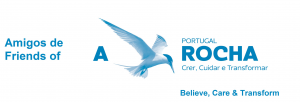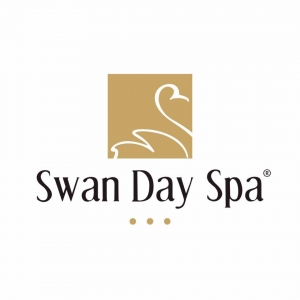
Newsletter September 2018
Bird migration is starting!
Thank you for being ‘A Friend’, we hope you enjoy this month’s articles.
Helen & Filipa

S
N
A
P
SHOT

Peter & Miranda Harris

Age: 65 and 64
Nationality: British
Job: Founders of A Rocha.
Peter is the President
Miranda is a co-founder of A Rocha International (ARI)
How did A Rocha start? In England in the early 1980’s everyone was talking about the environmental crisis. Well, almost everyone… It seemed that those of us who are Christians weren’t really aware of the problem. We live in such an incredible world! Such wonderful mountains & forests, oceans, beaches, creatures of all shapes, colours & sizes – people too! Sunrises, sunsets, predictable seasons (if not always quite enough sunshine for the summer holidays, or quite enough snow at Christmas). Crisis? What crisis?
At the time, Peter was working as a curate near Birkenhead, we had three small children, & we had been accepted by an Anglican Missionary society to work somewhere, maybe Tanzania, where we could help with theological education & building a church. The trouble was, nothing was really coming up in lights. Then Peter (who some say was born with binoculars around his neck…) led a student expedition to Sweden to study the migration of birds of prey and the Psalms. During that trip the idea for a Christian field study centre and bird observatory was born, not as a sort of excuse for explaining the gospel to people who aren’t Christians, but because caring for God’s creation has always been part of what Christians do, simply out of love for him. The bible speaks of God’s plan to restore ALL things, not just people, but places & birds & animals & everything else that he made & loves. So off we went…
A lot of people thought we were crazy! It was all going quite well in the church on Merseyside…. why would you go off & start counting birds? But as we began the hard work of learning Portuguese, training as a bird ringer (Peter) & searching for a site for the centre, everything slowly fell into place. You can read our book ‘Under the Bright Wings’ if you want to find out more about those heady days. Countless people joined the Cruzinha ‘family’ for longer or shorter periods of time. Some of the people we met as students then, are the centre directors you know now Marcial & Paula! But by the early nineties the secret was out, & people from other countries began asking for help. Soon there were five A Rocha organisations, in France, Kenya, Lebanon & U.K. as well as in Portugal, & not many years later, the work was growing exponentially, so that when the leaders meet for the Annual Forum, twenty countries are represented. This is clearly something that God is doing around the world, & we have the privilege of joining in wherever we are.
A Rocha has changed our lives completely – in a good way! The truth is, it’s not really what we do, and it’s who we are. And honestly, if I wasn’t already involved, I would join!
What is your favourite bird? Peter: My favourite bird is the Bee-eater and the Hoopoe (the symbol of A Rocha Portugal for some time). Miranda: My favourite is the Peregrine Falcon, I saw one during my last visit to Cruzinha!
IFO’s – Identified Flying Objects…


Crimson-Speckled moth (Utetheisa pulchella, Linnaeus, 1758)
Morphology: It is a moth from the Erebidae Family, with a wingspan between 29 to 45 mm; the forewings are narrow, whitish with a variable pattern of black and orange spots, and the hindwings are wide, white with a dark margin and with two black marks in the middle. It sits with wings folded close to its body. It is plurivoltine, which means they lay eggs several times a year; it flies from March to November, at day and at night and it is attracted to light.
Habitat: Coastal dunes, rocky areas, meadows, grasslands and other dry vegetated habitats.
Distribution: It occurs in the tropics and sub tropics of Africa and Asia; in Europe it is only present in some coastal areas of the Mediterranean. It can migrate and occasionally it is found further north.
Notes: The caterpillars are polyphagous (eats different grass species), but seems to prefer plants from the Boraginaceae Family, such as Echium species. Due to their feeding habitats, the caterpillars can accumulate a large amount of alkaloids and can be untasty to predators; the colour of their wings are a sign of warning.

Identification: It is a medium bird, quite distinctive, with a wing span from 44 to 48 cm; it has black and white striped rounded wings, and an erectile crest (normally raised on landing), bill long, narrow, slightly de-curved and a black tail with broad white band. Males and females are similar.
Habitat and Ecology: Open country such as pastures, parklands, orchards, olive groves and vineyards. It is often found around villages and traditionally farmed areas. It nests in natural holes in stumps, trees, walls, old buildings, cliffs and is normally relatively close to the ground. Spends much time on the ground where it feeds off large insects (larvae and pupae) and worms.
Tweet… Tweet…
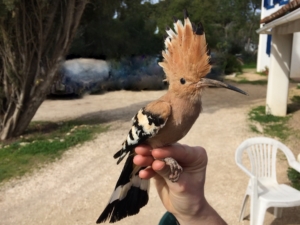
Eurasian Hoopoe (Upupa epops)

Distribution: Widespread in Europe, Asia, North Africa and sub-Saharan Africa. In Portugal it is a breeding bird, winters in Africa and resident bird in some areas (like in Alvor Estuary where it is present all year).
Threats: Least Concern in the International Union for Conservation of Nature (IUCN) red list. The major threats include hunting (in the Mediterranean region), habitat disturbance, as well as food availability and loss of nesting sites as result of habitat changes due to agricultural intensification.
DID YOU KNOW?

- Autumn is here and this is one of the best times to see different birds which are heading south! Some of the birds are just passing by, they are travelling from their breeding areas, more North, to their wintering areas, Africa! It is always worth having your binoculars close to hand; you never know what you might see!
- On the 2nd of August we caught our first migrant of the Autumn season, a Melodious Warbler (Hippolais polyglota) and a Willow Warbler (Phylloscopus trochillus). On the 9th of August we caught a Reed Warbler (Acrocephalus scirpaceus) which had a large amount of fat, this means it is preparing to migrate South.
Reed Warbler (Acrocephalus scirpaceus) Melodius Warbler (Hippolais polyglotta) Bird with fat
POPPED UP

Fig Cactus/Prickly Pear (Opuntia ficus-indica)
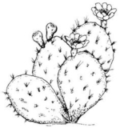
Identification: The prickly pear is big succulent shrub, a species of cactus from the Cactaceae Family. It has a thick, woody central trunk and a profusion of flat green, prickly pads. Sitting on the outer edges of the pads, large white, yellow or red flowers appear in spring or early summer. The flowers are followed by edible fruits that ripen from yellow to red. The plant typically grows up to 450 cm (15 ft) and 300 cm wide (10 ft).
Habitat and distribution: Arid and semi-arid environments. It is native from Mexico, but is naturalised in Southern USA, Australia, Africa, Southern Asia and the Mediterranean Region.
Notes: The prickly pear has been cultivated since ancient times because of it’s edible fruits (called tuna), in Mexico it is used to make an alcoholic drink: the “colonche” as well jams and jellies. It can also be used as a medical plant. Prickly pears are good crops for dry areas because it efficiently converts water into biomass and it improves the soils physical conditions, although it is considered a pest species in some areas of the Mediterranean spreading rapidly beyond the areas where it was originally cultivated.
PASSING BY


Name: Ian Souter and Jill Souter
Age: 65 (spoken low) and 61 (much younger!)
Nationality: British, Uk
Ian: I am a Methodist Minister. I am on a 3 month sabbatical for studying. I am studying Theology and Environment and that is the reason I am here! Jill: I am a nurse and I came with my husband, I am a freeloader! (laughing!).
This is our first time to A Rocha Portugal (March 2018), we came as visitors. But recently we visited the A Rocha UK, to visit the Minet Park, a Nature reserve in the middle of London. I first heard about A Rocha 15 years back throughout Dave Bookless in a Christian conference. A Rocha runs an Eco Church in England. My church in Bath is an Eco Church!
What does A Rocha mean to you? Ian: It is the practical out working of Christian faith in relation to the environment. Here the variety of bird life is great and also having people who understand about it and explain things to you; the sense of community and gently sharing Christian faith. Jill: For me it is like the practical integration of Christian beliefs about creation and God and putting that into practice.
With all the wonderful birds here, which is your favourite? Ian: My favourite bird is the Serin, it is just beautiful! Jill: I love the Black-Winged-Stilt, it is so elegant!
DATES TO REMEMBER

6th, 13th, 20th and 27th of September – Cruzinha Bird ringing display & Moth Talk (10.15am to 12 am)
8th to 9th of September – Cockle Festival in Figueira
23rd of September – Start of Autumn
28th of September – Sagres Wind Farm Friends Event
Come visit our stand at the Sagres Birdwatching Festival from 4th to 7th of October
http://www.birdwatchingsagres.com/
September: Migration really kicks-off in September and even if Sagres is an obvious destination for “birding” any place can be good to look for birds. Wetlands also get packed with waterbirds and it is a good time to look for American waders!
www.arochalife.com Check the website for more information on dates for organised tours

Thank you for supporting the Friends of A Rocha Portugal

Dr Roy Rodrigues
Av. Do Brasil, Qta das Palmeiras, Lt P2, R/c A, 8500-299 Portimão
(+351) 282180683
royaldente@gmail.com

Sítio da Amoreira, Lote 12,
Alvor, 8500-045 Portimão
(+351) 282412562/ 925433047
www.transfair.com.pt
Microplastics by Bart Steen
In my opinion Microplastics are evil, and everyone should know about them. Through our questionnaires we have discovered many people know about how microplastics disrupt food chains, kill marine animals and threaten human health as well. The EU’s answer to getting rid of the plastic waste was to send 45% of it to China… until 2018. China has closed its borders. It is now even more of our problem.
At A Rocha we make people aware of this. Besides questionnaires we have open days, do beach cleanups and we are conducting samplings on beaches in the Ria de Alvor area. That sampling is our main activity: we are putting the areas of greatest pollution in the Ria de Alvor on the map.
Samples have been collected since February 2017 and will continue to be collected until February 2019. Several beaches will be sampled multiple times to research the evolution over time and the effects of the touristic season. A healthy beach is one without microplastics.
The results may give us hints as to what the greatest problems are. For instance, we have been finding relatively large amounts of foam on beaches close to the Arade river mouth. There is a fishing harbour there. Fishermen use foam to make the bait float. It may be an environmental problem.
Science is a guideline for environmental policy and frequently guides conservation efforts. The findings of our sampling will be analyzed and are intended for publication. On that front also, A Rocha is active.
For further information, look on the website: www.arocha.org
Thought of the month
“Many people think that patience is a sign of weakness. I think this is a mistake. It is anger that is a sign of weakness, whereas patience is a sign of strength.” Dalai Lama
Chosen by Helen Rodda

Friends Event: The Sagres Wind Farm/Monday 28th September 2018/ €40 per ticket
(*non – refundable)
A Day trip for 8 people (Friends ONLY) to Sagres and to the Wind Farm of Barão de São João, to watch the soaring birds. We will be guided by A Rocha expert Birder – Guillaume Réthoré (Gui) who will show us the places where we will hopefully see Griffon Vultures, Black Storks, Booted Eagles and other soaring birds.
The day will start from Cruzinha at 8.30, we then go by mini-bus (driven by Gui) to Sagres. We should arrive at our destination one hour later.
We go to the Cabranosa (elevation point) to see the soaring birds and some other migrants that might be around the pine trees (staying there for about 1 hour).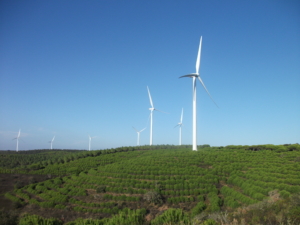
We then drive on a dirt road towards Vila do Bispo, where it will be possible to see Choughs, Kestrels. We will then drive to the Wind farm at Barão de São João, there we will watch the turbines and hopefully see Bonelli’s Eagle and Peregrine Falcon, we will picnic here under the pine trees.
We should be back at Cruzinha at about 4 pm.
There are only 8 places available for this special Friends Event, so book early so you are not disappointed.
*Tickets are for Friends ONLY and are €40.00 (this includes minibus travel & our guide).They are non-refundable due to the extremely low price of the event, to ensure costs are covered.
Your Check List for the day:
Please wear sensible walking shoes
It’s a good idea to wear a hat/or at least bring one in case it is very hot
Please provide your own picnic lunch
Only 2 places available!
Soaring Bird Migration and Wind Farms by Gui
The Sagres Peninsula, and especially the small hill called Cabranosa, is famous for the migration of soaring birds in the autumn. However, to get to and then out of the peninsula, these birds need to cross several wind farms. These places are known to be dangerous for birds, that is why several of them are monitored to control and reduce bird mortality. One of the companies (STRIX) has been doing this monitoring for about a decade and managed a mortality rate of none almost every year (1 bird at the maximum) during the autumn migration.
In order to achieve this, a team of up to 10 people (birders) are mobilized each day for the whole day to monitor the Soaring Bird Migration. Some of these people are in the wind farm enclosure, others out in the surrounding countryside and one of them (the lucky one) is inside Cabranosa. They are in radio contact, when birds fly through the wind farm area, data such as the species, number, altitude are collected. If the bird or birds match some specific criteria, the turbines can be shut down in order to let them fly through the wind farm. When first applied, this methodology was quite unique in Europe. Nowadays, more and more wind farms use these kinds of techniques to ensure the lowest mortality rate for soaring birds.
(As a Friend you have an opportunity to visit one of these Wind Farm areas on a Friends Event organized on the 28th of September, check the article above).
Cockle (Cerastoderma edule)

The edible cockle is a mollusc with a thick, solid, globular shell up to 5 cm long with two valves. The shell has radiating ribs, crossed by concentric ridges and it may have short, flat spines. Its colour varies from the buff white to yellowish or brownish. Inhabits the surface of sediments, burrowing to a depth of 5 cm. It can be found on clean sand, muddy sand or muddy gravel, in intertidal areas, in estuaries or sheltered bays; it feeds of small particles collected by filtering the water. The cockle it is one of 57 species of bivalves of the Alvor Estuary, they are an important food resource not just for the birds but for the local populations as well. The cockle harvest (as well as other bivalves) it is a tradition in the Alvor Estuary and an important economic resource for the local communities. You can see this tradition by pictures on the book: “Shellfish Catchers, Ria de Alvor: Stories of a place” by João Mariano.


BERBIGÃO À ALGARVIA
Recipe
Put the 1 KG of Cockles in a bucket of well salted water, use about 6 tablespoons of rock salt (to release the sand that might be inside the shell) for at least 2 hours.
1 kg of Cockles
1 Garlic Bulb
4 tablespoons of Olive oil
1 bunch of Coriander

Put the olive oil and garlic (smashed with the skin), in a frying pan and fry until golden brown; add the cockles, when the shells start opening add the coriander. Keep stirring until all the shells open. Serve it with fresh bread and a chilled glass of white wine.
If you have any queries please do not hesitate to contact us: friends.arpt@arocha.org
Our office is open from Monday to Wednesday from 9:00 to 12:00 am
Or visit us on our open day: Thursdays from 10:15 to 12:00 am
See map https://arocha.pt/en/contact-us/
GPS coordinates: 37°08’39.8″N (37.1444) 8°36’29.2″W (-8.6081)
(+351) 282 968 380
Thank you for supporting us!
Hope to see you soon!
